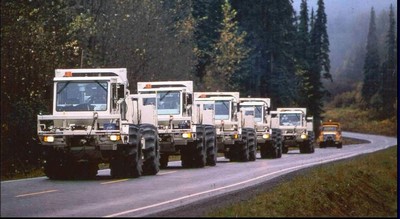In 1984, the Geological Survey of Canada was a founding partner in Lithoprobe, one of the world’s most successful deep investigations of Earth’s structure. The work took place across Canada over the next 20 years, generating an almost continuous cross-section of Earth’s crust up to 40 kilometres deep.
At the heart of Lithoprobe were profiles of seismic refraction – created by huge ground-pounding trucks, nicknamed “dancing elephants,” which punched sound waves deep into Earth to bring back pictures of its hidden geology. These were combined with multidisciplinary investigations of gravity and magnetic fields, electrical sounding, geochemistry, industrial drilling, and detailed geological mapping. Lithoprobe brought together over 500 government, university, and industry scientists, and resulted in over 1500 publications, books, and educational products.
Among the results were a revolutionary new understanding of Canadian geology, resurgences in mineral and hydrocarbon exploration, new technological developments, and a cadre of new young geoscientists in Canadian universities who had participated in Lithoprobe.
Category: Science Advances
Decade: 1980s
References
Clowes, R.M., 2009. A new view of the continent beneath our feet: LITHOPROBE’s scientific, economic and social contributions; CSEG Recorder, v. 34, no. 3, p. 7-16.
Wilson, J., 2003. Dancing Elephants and Floating Continents: The Story of Canada Beneath Your Feet; Key Porter Books.


